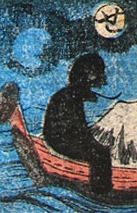Fukaubete: Difference between revisions
No edit summary |
No edit summary |
||
| Line 5: | Line 5: | ||
A '''Fukaubete''' is a Janpian maritime [[Mathaska]], often depicted as a human-like entity who assists the ship's crew in their daily lives, preventing any accidents and guiding the crew in the right direction. It is said that each ship has a single Fukaubete, which also bears the same name as the ship. Furthermore, they were also believed to be responsible for guiding the ship when its navigating in heavy fog, and giving a sense of enlightenment to the crew. They were also occasionally blamed for some unexplained disappearance of common objects from their last remembered place, only to resurface in an unexpected location somewhere in the ship. | A '''Fukaubete''' is a Janpian maritime [[Mathaska]], often depicted as a human-like entity who assists the ship's crew in their daily lives, preventing any accidents and guiding the crew in the right direction. It is said that each ship has a single Fukaubete, which also bears the same name as the ship. Furthermore, they were also believed to be responsible for guiding the ship when its navigating in heavy fog, and giving a sense of enlightenment to the crew. They were also occasionally blamed for some unexplained disappearance of common objects from their last remembered place, only to resurface in an unexpected location somewhere in the ship. | ||
Despite the Fukaubete's neutral or good nature with the crew and the vessel, they accompany a curse. It is said that no matter what they do, they would not be able to directly interact with the crew | Despite the Fukaubete's neutral or good nature with the crew and the vessel, they accompany a curse. It is said that no matter what they do, they would not be able to directly interact with the crew that they bond with, and the closest they could do so is by alternating their judgement. Given the Fukaubete's invisible nature, they are also easily forgotten by the crew, who may not even realize or appreciate their help. Although, it is also said that Fukaubete only appear to those who are seconds away from their deaths, possibly giving comfort to the doomed crew, and on some domain versions, showing them their ill-fates on their spiritual afterlife. | ||
In most depictions, the Fukaubete is said to be wearing a naval uniform, topped with a yellow coat that also covers its head up to its face. Sometimes, it is said that the Fukaubete wears the same common uniform of its crew, or appear as a bright young maiden in a naval uniform. In other times, it is said that they also appear as a giant, black entity, which is more common to appear in storms. | In most depictions, the Fukaubete is said to be wearing a naval uniform, topped with a yellow coat that also covers its head up to its face. Sometimes, it is said that the Fukaubete wears the same common uniform of its crew, or appear as a bright young maiden in a naval uniform. In other times, it is said that they also appear as a giant, black entity, which is more common to appear in storms. | ||
== Origin == | == Origin == | ||
The exact origin of Fukaubete is unknown, as there are no references to where exactly did it began or how it started. Earliest mentions of Fukaubete dated back to as far as the 1st era, although it gained more significance or sightings during the 2nd or 3rd era, mainly coming from sightings or reports from shipwreck survivors. Historians theorized that the surge of sightings in the 2nd and 3rd era could be explained as just a stowaway, or an undocumented and unfamiliar individual crew of the | The exact origin of Fukaubete is unknown, as there are no references to where exactly did it began or how it started. Earliest mentions of Fukaubete dated back to as far as the 1st era, although it gained more significance or sightings during the 2nd or 3rd era, mainly coming from sightings or reports from shipwreck survivors. Historians theorized that the surge of sightings in the 2nd and 3rd era could be explained as just a stowaway, or an undocumented and unfamiliar individual crew of the ship. | ||
== Legends by area == | == Legends by area == | ||
Revision as of 18:01, 17 September 2024
A Fukaubete is a Janpian maritime Mathaska, often depicted as a human-like entity who assists the ship's crew in their daily lives, preventing any accidents and guiding the crew in the right direction. It is said that each ship has a single Fukaubete, which also bears the same name as the ship. Furthermore, they were also believed to be responsible for guiding the ship when its navigating in heavy fog, and giving a sense of enlightenment to the crew. They were also occasionally blamed for some unexplained disappearance of common objects from their last remembered place, only to resurface in an unexpected location somewhere in the ship.
Despite the Fukaubete's neutral or good nature with the crew and the vessel, they accompany a curse. It is said that no matter what they do, they would not be able to directly interact with the crew that they bond with, and the closest they could do so is by alternating their judgement. Given the Fukaubete's invisible nature, they are also easily forgotten by the crew, who may not even realize or appreciate their help. Although, it is also said that Fukaubete only appear to those who are seconds away from their deaths, possibly giving comfort to the doomed crew, and on some domain versions, showing them their ill-fates on their spiritual afterlife.
In most depictions, the Fukaubete is said to be wearing a naval uniform, topped with a yellow coat that also covers its head up to its face. Sometimes, it is said that the Fukaubete wears the same common uniform of its crew, or appear as a bright young maiden in a naval uniform. In other times, it is said that they also appear as a giant, black entity, which is more common to appear in storms.
Origin
The exact origin of Fukaubete is unknown, as there are no references to where exactly did it began or how it started. Earliest mentions of Fukaubete dated back to as far as the 1st era, although it gained more significance or sightings during the 2nd or 3rd era, mainly coming from sightings or reports from shipwreck survivors. Historians theorized that the surge of sightings in the 2nd and 3rd era could be explained as just a stowaway, or an undocumented and unfamiliar individual crew of the ship.
Legends by area
Fukaubete is notably popular in the Beluren Domain, particularly in the Munschen Island, where they are believed to be the spirits of people who went missing or died on the ocean, and cannot find their way to the Munschen River to cross the bridge to the afterlife. Due to this, these spirits began travelling on any ship that they spot, hoping that it will eventually bring them to the river. This significance eventually became the mythical foundation of the Port of Munschen which stands on a bay across the river, to historically serve as a cleansing point after a long voyage in the ocean, or to bless the ships before they set out to the sea. The port is currently the largest nautical trading and construction hub in Janpia, and the home of the 1st Magochyo Fleet, which is the largest revolutionary naval group
Fukaubete in fiction
- In the romantic comedy animation "Khliya (Cloud)", a certain Fukaubete has met a new a sailor of a ship which she soon grew fond of. But given that she is a Fukaubete, she cannot directly interact with him or grab his attention, but he could at least see how the sailor judges the situation. Soon, she began taking the sailor's items to let him know of her presence and to get his attention, which has led to the sailor suspecting that the Fukaubete hated and look down on him.


